Every Day is Braai Day
Accepting; VISA | Mastercard | InstantEFT | PayFast | YOCO | OZOW | PayJustNow
With PayJust Now, you can pay your order with 3 Interest FREE instalments!

Item added to your cart

Safari Briquettes
Couldn't load pickup availability
Experience the wild with Safari Briquettes! These high-quality briquettes are specially designed for all your outdoor adventures. With their long-lasting burn and powerful heat output, you can enjoy warm campfires, delicious BBQs, and cozy nights under the stars. Fuel your next adventure with Safari Briquettes!
Product Dimensions
Subscribe to our emails.
Be the first to know about New Arrivals, News from the Braai Room, Exclusive offers, great Braai Ideas, Recipies & Tips.
- Choosing a selection results in a full page refresh.
- Opens in a new window.

Experience the taste of
What makes us different, 100% hardwood, additive free, burns better, lasts longer, fast easy lighting, from sustainable forests, welcome to bosveld charcoal.
South Africa’s largest supplier of charcoal, briquettes and related braai products and accessories.
Braaing is one of South Africans’ favorite pass times, where friends and family enjoy a great meal together, prepared over hot coals just like our forefathers did 100’s of years before.
Our favorite pass time is world-renowned and albeit most other countries believe their method of BBQ’ing is best, we know better, do it better and enjoy it as it should be.
Bosveld Charcoal is the only supplier that guarantees its products with a full money-back commitment . This is because we’re confident that no other product on the market competes with the Bosveld Charcoal quality.

Our Products

Caps & Hat's

Spice & Sauces

Accessories
Popular products.

Military Green Jacket

Stainless Steel Braai Grid – Large

Patio Braai – Standard – Rotissory skewer

Charcoal Spade

Black with White Branding

Steak Tong (335mm)

Bottle Opener

5 Pack Firelighters(5x combo Pack deal)

Prego Sauce (250ML)
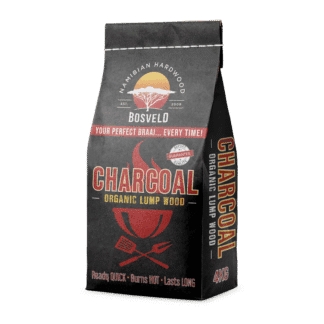
Namibian Hardwood Charcoal

8KG Kameeldoring

Himalayan Salt – 200ml (ETOSHA)

You're shopping:
Delivery to:
Slots available from:
As early as today
- All Products
- Home, Appliances & Outdoor
- Charcoal, Wood & Lighters
Safari Briquettes 4kg

Product Info
We think you may like these.

Customers also bought these
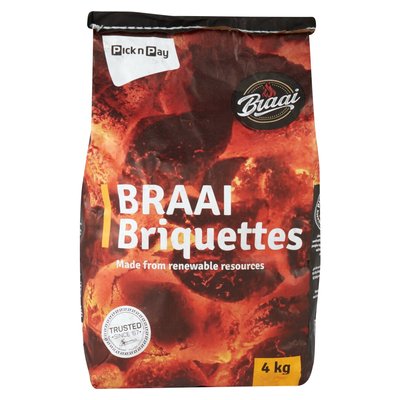

Ignite Premium Blend Briquettes - 4kg
In Stock | Ships from our store
- Payment Options We have a number of payment options available to you View Details
Product details
Ignite charcoal briquettes.
Crafted from a premium blend of southern Africa's finest charcoal.
Known as the versatile choice in grilling, not all briquettes deliver the same performance. Ignite Briquettes stand out thanks to extensive research and testing, resulting in the perfect combination of wood species for long-lasting burn time , high heat output , and durable briquettes that arrive intact, ready for your barbecue.
While the exact blend is our secret, we guarantee that every Ignite briquette is ethically and responsibly sourced , with no artificial binders , for an all-natural charcoal grilling experience.
Customer Reviews
Success! Ignite Premium Blend Briquettes - 4kg has been added to your cart View Cart
- Choosing a selection results in a full page refresh.

Charcoal Briquettes
Our factory sources all bulk hardwood charcoal from several Namibian Farmers situated in the Northern region.
Intruder bush species are used for charcoal production in order to promote the resettlement of savannah grassland, and the eradication of these intruders. The most common species used are Senegalia mellifera (Swarthaak), Dichrostachys cinerea (Sekelbos) and Terminalia prunioides (Mushara).
Bulk charcoal is screened and the larger pieces (20-100mm) are packed for lump charcoal. The smaller screenings are then processed to produce the pillow-shaped briquettes. Maize starch is used as a binder and no chemicals are added.
The facility has an output capacity of 1500 tons briquettes and 3500 tons of charcoal per annum.
The charcoal for Shisa Nyama is sourced from the Eastern Cape region, from previously disadvantaged communities. These communities depend mainly on the income of charcoal production, and they contribute extensively to the eradication of Black Wattle trees in the ravines and conservation areas. Black Wattle trees are invader species in South Africa (when not planted in plantation formation). These trees are a threat to our indigenous Fynbos species in mountainous areas and exhaust the water resources in ravines, causing the drying up of rivers. Go on and support our South African Heritage by purchasing Shisa Nyama charcoal for your braai! Laat waai, daar’s ‘n Shisa Nyama Braai!

Safari-Charcoal-2kg

Safari-Charcoal-3kg

Safari-Charcoal-4kg

Safari-Charcoal-5kg

Safari-Charcoal-10kg

Safari-Charcoal-Polyprop-Bag

Safari-Briquettes-2kg

Safari-Briquettes-3kg

Safari-Briquettes-4kg

Safari-Shisa-Nyama-5kg
Privacy overview.
JavaScript seems to be disabled in your browser. For the best experience on our site, be sure to turn on Javascript in your browser.
- Compare Products
- Create an Account

# Type at least 3 characters to search # Hit enter to search
- Mixed Firewood
- Logs in Nets
- Bulk Bags of Logs
- Crates of Firewood
- Genuine 1 Ton of Firewood
- BBQ Supplies
- BBQ Wood (Smoking Wood)
- Pizza Oven Logs
- Chiminea Logs
- Wood For Firepits
- Wood Burner Logs

Utilising the Power of Wood Briquettes - Benefits and Uses
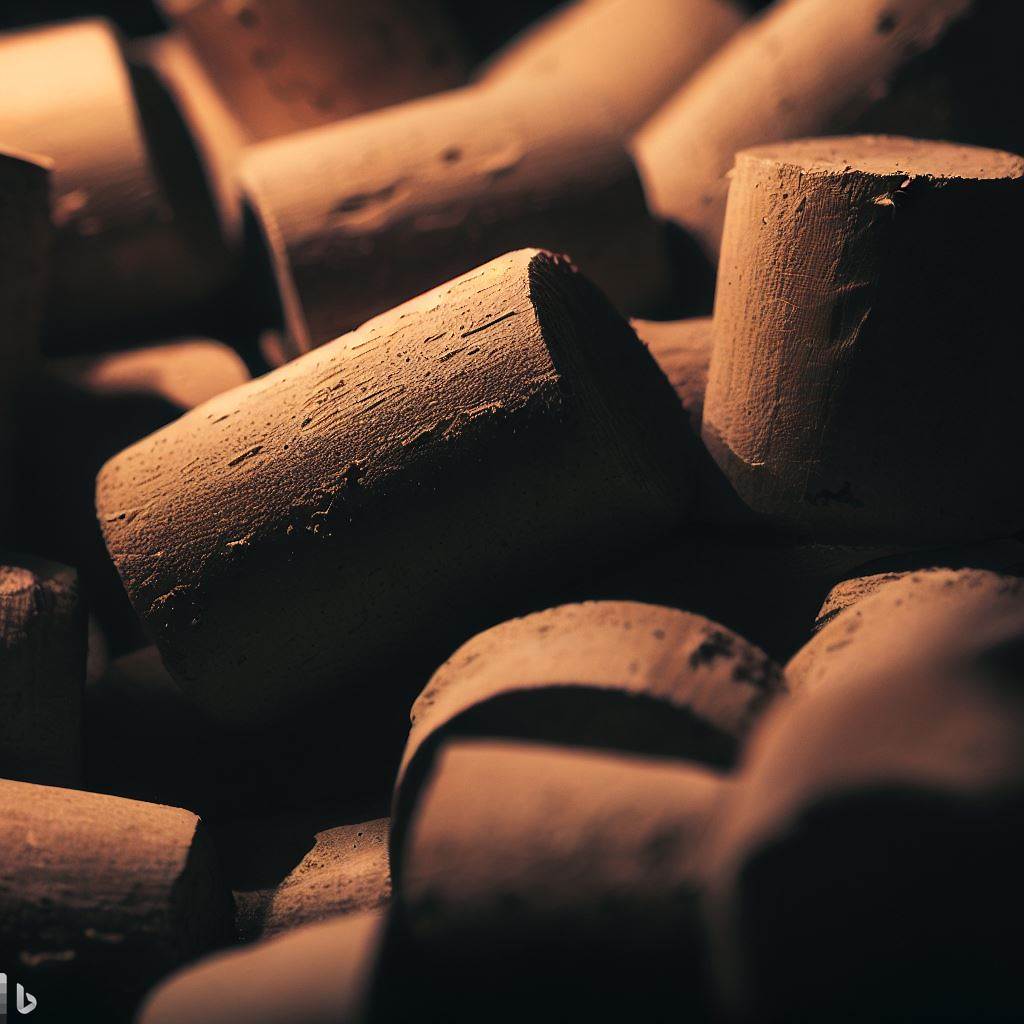
In our article, discover "what are briquettes" and delve into the advantages they offer in comparison to traditional logs and firewood. Explore the higher energy efficiency, reduced emissions, and longer burn time that pure wood briquettes provide. Uncover how these compact wood fuel sources are revolutionising the way we heat our spaces, with their convenient handling and storage.
Learn how quality briquettes are becoming an increasingly popular choice for eco-conscious individuals seeking sustainable and efficient heating solutions. Gain insights into the numerous benefits as you explore the possibilities of harnessing the power of wood briquettes.
What are Briquettes?
A definition from the Collins English Dictionary is:
“ Briquettes are a small brick made of compressed coal dust, sawdust,
Wooden briquettes (not to be confused with charcoal briquettes) are compact blocks, often brick shaped, which are made from compressed wood waste or biomass materials. They serve as a sustainable and efficient wood fuel source for various heating applications. In answering “ What are briquettes ”? we provide a definition, explain its composition, and discuss the production process.
A definition of wooden briquettes
Also known as biomass briquettes or heat logs, they are solid fuel blocks manufactured by compressing wood waste or biomass materials under high pressure. The compression process removes moisture and binds the particles together, creating dense and uniform blocks that can be used as a reliable and eco-friendly fuel alternative.
What are briquettes made of – composition explained
Wood waste, such as sawdust or wood shavings, is commonly used as the primary feedstock for wooden briquettes. Other biomass materials like agricultural residues, nutshells, or even paper waste can be mixed in for added benefits, this is why they are sometimes called biomass briquettes. They are environmentally friendly as many materials included would otherwise have ended up in landfill.

Other types of fuel briquettes
Our focus in this article is wooden quality briquettes, there are many different types of fuel briquettes including:
- Charcoal briquettes - wooden briquettes are often confused with lump charcoal briquettes. There are similarities between the two with charcoal briquettes being made from carbonised wood, coal, and other carbon-rich materials. When burned inside charcoal briquettes emit carbon dioxide and as such should not be burned indoors
- Peat briquettes - these are compressed blocks made from raw peat moss. They burn at a very high temperature, have a unique aroma and are commonly used as a fuel source for heating and open fires
- Sawdust briquettes - are also similar but use almost exclusively sawdust to form the sawdust briquettes as opposed to other materials.
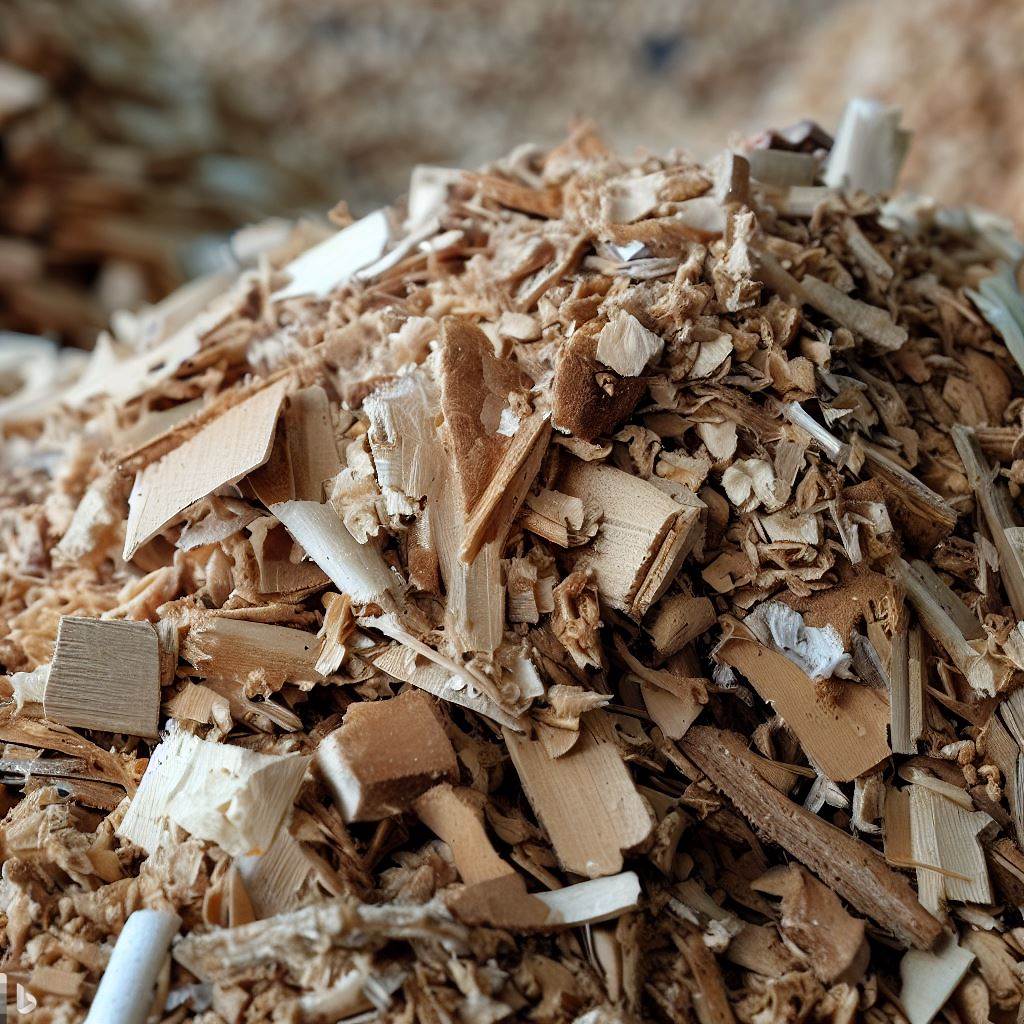
Some of the materials used in the composition of wooden briquettes
Production process
The production process for wooden briquettes includes the following steps:
- Drying - the mixture (often called feedstock) is dried to reduce its moisture content. This ensures better combustion and prevents excessive smoke or emissions during burning
- Grinding - the dried material is finely ground to obtain a consistent particle size. This step helps in achieving uniformity in the briquette composition and ensures optimal compression
- Mixing and binding - the ground feedstock is mixed with binding agents, often a natural adhesive such as lignin or starch, to enhance the cohesiveness and strength of the briquettes. The binder helps the particles stick together during compression
- Compression - the resulting mixture is subjected to high levels of pressure within a briquetting machine or extruder. The pressure creates compressed material, forcing the wood fibres to bind together and form solid blocks
- Cooling - once the briquettes are formed, they are allowed to cool and solidify
- Packaging - they can finally be packaged and stored for sale and transit
What are the advantages of briquettes?
There are many advantages of briquettes as a fuel source, making them a great choice for various heating applications. Below we explore some of the main benefits of wood briquettes:
1) High energy efficiency
Wood briquettes demonstrate exceptional energy efficiency, allowing them to generate a substantial amount of heat from a relatively small volume (which is why they are often called heat logs). This remarkable efficiency ensures the fuel is used optimally, extracting the maximum heating potential. By efficiently converting biomass materials into heat energy, wood briquettes offer an efficient and sustainable heating solution, contributing to cost reductions and reducing environmental impact.
2) High calorific value and energy density
They have a high calorific value, are very energy rich and have a high energy density. This means they contain a substantial amount of energy per unit mass or volume, resulting in sustained and long-lasting heat output.
3) Cost-effectiveness
Choosing briquettes is a highly cost-effective choice when compared to many other fuel sources, making them a right choice for budget-conscious or restrained buyers. They are often competitively priced, providing excellent value for money. Considering their high energy efficiency and extended burn time, wood briquettes offer significant savings in fuel costs over time.
Their ability to generate substantial heat from a relatively small volume means that less fuel is required to achieve the desired warmth, resulting in cost savings. Additionally, the longer burn time of wood briquettes reduces the frequency of refuelling, further contributing to cost-effectiveness. With their cost advantages, wood briquettes allow individuals to enjoy efficient and economical heating without compromising on warmth and comfort.
4) Long-lasting heat
They burn longer, making them an excellent choice for sustained warmth. Their dense composition allows for a slow and steady burn, ensuring a consistent release of heat over an extended period. This characteristic eliminates the need for frequent refuelling, allowing you to enjoy uninterrupted warmth without interruptions or constant maintenance.
The efficient and sustained heat output of wood briquettes makes them particularly well-suited for heating applications where consistent warmth is desired, such as in a wood burning stove or fireplace during chilly winter nights. With wooden briquettes, you can experience efficient and long-lasting heat, creating a cosy and comfortable environment for you and your family and friends.
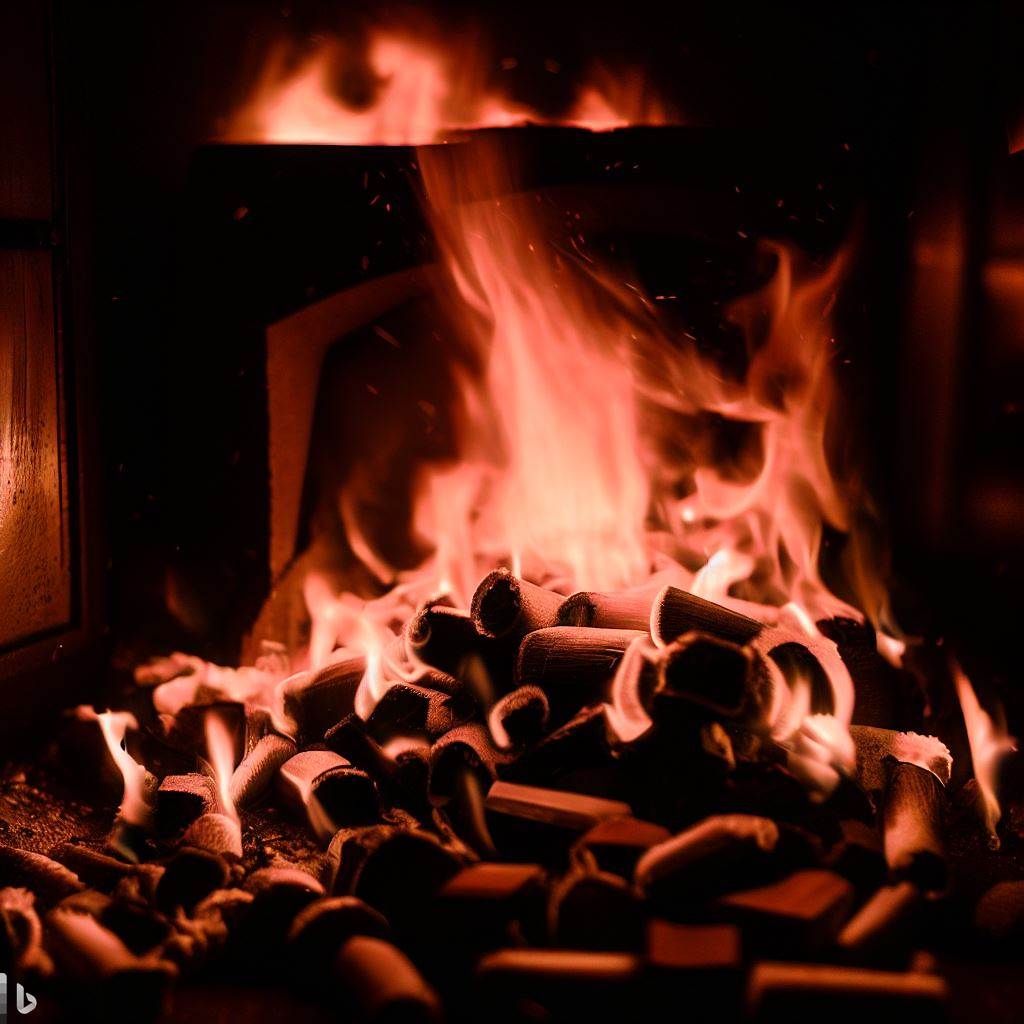
Wooden briquettes ablaze
5) Environmentally friendly qualities
Another one of the advantages of most briquettes is that they are an environmentally friendly choice for heating and reduce the use of fossil fuels. They are typically made from recycled wood waste or sustainably sourced biomass materials, reducing the need for new timber harvesting. Additionally, wooden briquettes produce lower emissions and have a lower carbon footprint compared to fossil fuels. So, buy wooden briquettes as a sustainable fuel source, one which uses materials which would otherwise often have ended up in landfill.
6) Consistency of moisture content
They are manufactured with controlled moisture content , ensuring a consistent burn. Lower moisture levels contribute to better combustion, very little smoke production, and improved overall heating efficiency.
7) Resistance to mould and pests
Due to their manufacturing process and compact nature, wooden briquettes are less susceptible to mould growth and pest infestations compared to traditional firewood . This ensures a clean and hassle-free fuel source for heating.
8) Ease of storage and handling
Wooden briquettes have a compact size and uniform shape, making them easy to handle and stack. Their standardised dimensions save storage space, maximising space utilisation. They are also easier to transport compared to bulkier firewood logs.
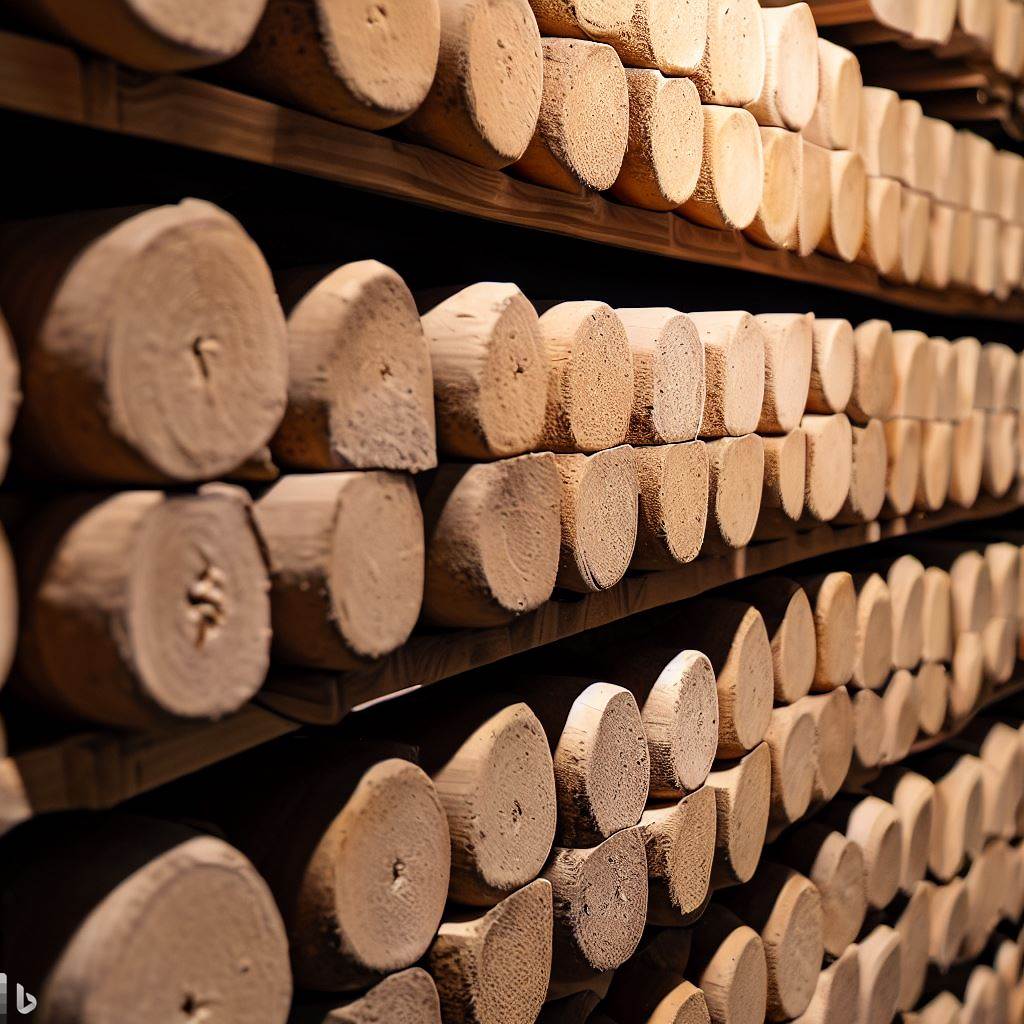
Wooden briquettes are easy to stack, store and handle
A versatile choice!
Wood briquettes offer versatile applications, making them a flexible fuel source for various heating needs and beyond.
Wood burning uses
Wood briquettes are highly suitable for use in a wood burning stove , wood burner, or in fireplaces, and boilers. Their compact size and uniform shape make them easy to handle and fit into these heating appliances. Whether you want to warm up your living room, create a cosy atmosphere, or generate heat for cooking, wood briquettes provide an efficient and reliable fuel option. To get a fire started, we would recommend using them with kindling .
A variety of other applications
In addition to residential heating, wood briquettes find applications in commercial and industrial settings. They are commonly used in restaurants, hotels, and other businesses that use wood-burning appliances for heating or cooking purposes. Moreover, wood briquettes play a role in industrial processes that require a sustainable and cost-effective wood fuel source, such as in the manufacturing sector or energy generation.
The versatility of wood briquettes extends beyond traditional heating applications. They can be used in barbecues (charcoal briquettes and peat briquettes burn well too), outdoor fire pits, and camping trips to create a warm and inviting atmosphere. With their clean burn and reduced emissions, wood briquettes are a preferred choice for environmentally conscious people in a range of settings.
Wood briquettes vs firewood
When comparing wood briquettes vs firewood, several key differences emerge. Wood briquettes are denser and more compact, providing a higher energy density and longer burn time compared to firewood.
They have a consistent low moisture content, ensuring reliable and efficient combustion. Wood briquettes also ignite more easily and produce less smoke, very little ash and emissions. Additionally, their uniform shape and standardised dimensions make them easier to handle, stack, and store compared to irregularly shaped firewood logs.
Overall, wood briquettes offer a convenient, efficient, and eco-friendly alternative to traditional firewood, providing consistent heat output and reducing environmental impact and fossil fuels use.
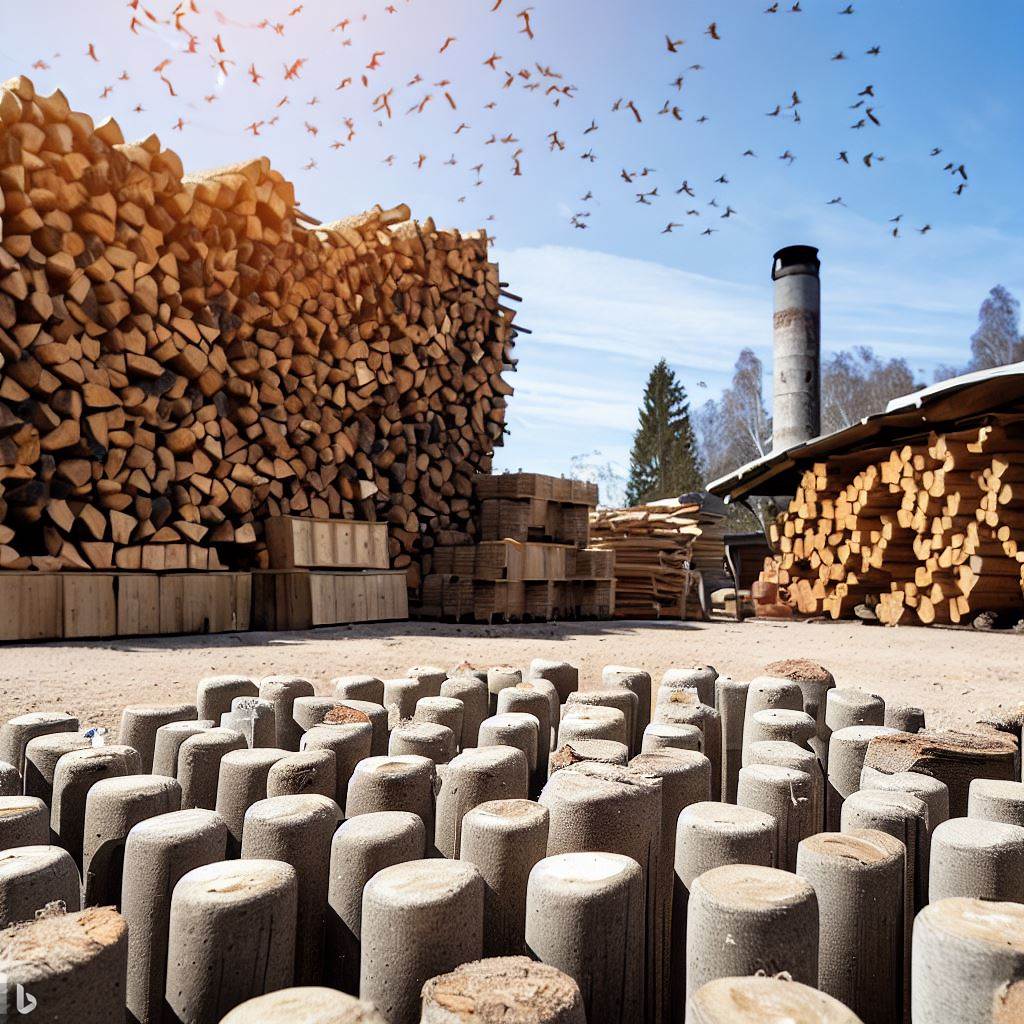
Wooden briquettes, firewood and kiln dried logs are all options
Wood briquettes vs logs
When comparing wood briquettes vs logs, there are notable distinctions. Wood briquettes have a higher energy density and burns longer compared to kiln-dried traditional logs.
They are more compact and have a lower moisture content, resulting in efficient combustion and virtually smokeless production. Wood briquettes are easier to handle, stack, and store due to their uniform shape and standardised dimensions.
While both options provide a convenient and eco-friendly wood fuel source, wood briquettes offer the advantage of longer-lasting heat (hence the alternative name heat logs) and improved consistency in performance.
Briquettes available from Cozilogs
Buy Cozilogs high density, high heat output, virgin pure wood quality briquettes. These are manufactured from timber, which has been sourced from sustainably managed and 100% UK virgin woodlands and forests. With a low moisture content of around 12%, buyers are guaranteed a clean and efficient burn. Briquettes are made to around twenty five centimetres (ten inches) in length. View our briquettes made in the UK at https://www.cozilogs.co.uk/bulk-briquettes-pallet.html . Products include:
- Full pallet – weighing 960kgs - click here
- Half pallet – weighing 480kgs – click here
- Quarter pallet – weighing 240kgs – click here
We hope you found our article on "Utilising the Power of Wood Briquettes - Benefits and Uses" informative and helpful. If you have any further questions or enquiries regarding “what are briquettes,” or comparing briquettes vs logs or briquettes vs firewood, or the advantages of briquettes, please feel free to contact us.
You can call us at (01905) 954 736. Alternatively, you can complete our contact form , and we will promptly respond to your query.
- Storing logs outside: Should you keep them in bags? [UPDATED]
- How Outdoor BBQ Wood Logs Enhance Your Grilling Experience and Unlock the Flavour [UPDATED]
- The Ultimate Guide to Safe Firewood Splitting [UPDATED]
- Firewood Safety: Preventing Hazards in Wood Burning
- A Step by Step Guide for How to Build a Log Store
- Emily Martin on Woody Oven 12 Pizza Oven Giveaway
- Andy Smith on Woody Oven 12 Pizza Oven Giveaway
- Alice lightning on Woody Oven 12 Pizza Oven Giveaway
- Andrew Phillips on Woody Oven 12 Pizza Oven Giveaway
- Christine Caple on Woody Oven 12 Pizza Oven Giveaway
- February 2024
- January 2024
- December 2023
- November 2023
- October 2023
- September 2023
- August 2023
- January 2023
- November 2022
- September 2022
- October 2021
- Buying Guide
- Kiln Dried Logs
- Uncategorized
- Magento WordPress Integration
- Magento Extensions
Wood Briquettes vs. Traditional Firewood: What's Better At Heating?
Published on 13 February 2024
Wood briquettes and traditional firewood — what’s hot and what’s not? Our team has done the tests, and here are the results...
We already know wood briquettes offer numerous advantages over traditional firewood.
They not only comply with Air Quality Regulations and hold a 'Ready to Burn' certification, but they are also environmentally friendly, convenient due to their consistent shape and, as we explored in a previous blog, more cost-effective than traditional logs .
But, do briquettes pack more heat than a traditional wood log?
Yes. We've run some interesting experiments comparing how Lava Log® wood briquettes and firewood burns — it shows that not only do briquettes reach a higher temperature, but they do so for longer.
How did we compare the heat output of briquettes and logs?
Over the course of three days, we carried out three tests on briquettes and traditional wood logs, with each test lasting two and a half hours.
Before each test, the wood burner was cleared of ash, set with a hotbox firestarter and two Lava Logs® (each broken into two pieces) for the briquette test; and four wood logs (of a similar weight) for the log test. See images below.
A wood stove thermometer was fixed to the door of the burner to allow us to take a reading every thirty minutes.
Wood burner settings
Due to the consistent burn of wood briquettes, the vents on the wood burner were left open for the first thirty minutes, closed for one and a half hours and then opened again for the final thirty minutes.
Unfortunately, the same approach couldn't be used with the wood logs and greater care had to be taken to ensure the logs burnt at the optimum level.
Briquettes vs. logs heat comparison: what were the results?
See the temperature readings below (shown in degrees celsius (°C)):
Highest recorded temperature
- Briquettes : 220
- Traditional Wood Log : 170
Highest average temperature held over 30 minutes
- Briquettes : 198
- Traditional Wood Log : 117
Highest average temperature held over 60 minutes
- Briquettes : 176
- Traditional Wood Log : 99
Average temperature at 2 hours 30 minutes burn time
- Briquettes : 92
- Traditional Wood Log : 30
The air temperature outside on each of the three test days was as follows :
- Day 1: -2.5
So, there we have it — not only are briquettes more cost effective than logs , but they burn considerably hotter!
Lava Log® wood briquettes: high-performance, sustainable heating for your home
As the name suggests and the experiment above shows, each Lava Log® kicks out some excellent long-term heat.
Fancy getting your hands on some of your own? They are available to buy through our e-commerce store in three pack sizes to suit your needs, with free UK-wide delivery and collection available.
Related Articles
- Wood Briquettes vs. Traditional Logs: A Definitive Price Breakdown
- Wood Briquettes Storage & Usage: A Quick Guide
- Wood Fuels Guide: Biomass Pellets, Briquettes & Logs Compared
Ready to start your project?
Enquire about wood briquettes vs. traditional firewood: what's better at heating.

- Kiln Dried Logs
- Express Bundles
- Ready Mixed Pallets
- Mix Your Own Pallet
- Wood Pellets
- Firelighters & Kindling
- Pizza & Outdoor Living
- Add-on Products
- Dumfries Shop
- Blog | Information & Inspiration
- Wood Fuel Guides
- Wild Bird Information
- Environmental Responsibility
- Charitable work
Recent Posts
Wood briquettes vs logs.
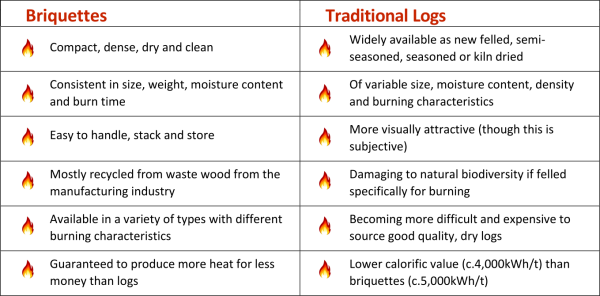
Are you trying to decide between wood briquettes vs logs?
Here we explain the difference between wood briquettes vs logs. Sourcing dry wood fuel at an affordable price can be hard – and getting good advice can be even more difficult. We’ve been burning wood fuel for many years and are dedicated to helping you find the best product for your stove.
As an indication of our preference, we have seven members of staff working at the Wood Fuel Co-op. We all have a choice between wood briquettes and logs and none of us would ever go back to burning logs!
Wood briquettes are much hotter, cleaner, longer burning and more economical than traditional logs. This isn’t a subjective opinion; the impressiveness of briquettes comes down to pure physics. A dry, dense briquette has better burning properties than a traditional log, and the choice available means there’s something for everyone. Briquettes also recycle a pure wood waste product, which means less going to landfill. It also means that trees are not having to be felled specifically to make firewood.
Now that Ready To Burn legislation prevents wet wood from being sold, briquettes are more convenient than ever. That’s because they’re dry and consistent.
- Compact, dense, dry and clean
- Consistent in size, weight, moisture content and burn time
- Easy to handle, stack and store
- Made from recycled waste wood
- Available in a variety of types with different burning characteristics
- Guaranteed to produce more heat for less money than logs
Traditional Logs
- Widely available as new-felled, semi-seasoned, seasoned or kiln-dried
- Variable sizes, moisture content, density and burning characteristics
- Damaging to biodiversity if felled specifically for burning
- Becoming more difficult and expensive to source dry logs
- Lower calorific value (c.4,000kWh/t) than briquettes (c.5,000kWh/t)

Buyer’s Guide to Wood Briquettes

Buyer’s Guide to Traditional Logs

Information
- Wood Fuel Coop About
- General Information
- Wood Fuel News
- Terms and Conditions
- Pallet Deliveries
- Cookie Policy
- Parcel Deliveries
- Mix your Own Products

Wood Fuel Co-operative 170 Heathhall Industrial Estate Dumfries, DG1 3PH
Mon – Fri : 9am to 5pm Sat: 9am to 4pm (Oct-Apr) Sat: 9am to 1pm (Late May-Sept) Sun: Closed
Return to shop
Quick guide to choosing the best Wood Fuel for your stove and lifestyle.

*Break - We strongly recommend you break these briquettes in half (or less for very small stoves) because they do expand whilst burning and you don't want them to overfill the fire. *Easy to light - We always use a Firelighter and Kindling Sticks to start our fires. Most briquettes are graded four stars to light because they are quite dense and require kindling.
- All stove and flue combinations tend to have different burning characteristics. Fuel that works well in my stove may not work so well in your stove, and vice-versa.
- Most modern stoves are more efficient than most older stoves, meaning a modern quality stove will burn fuel more economically and generate more heat over a longer period.
- Always try to burn fuel with a 'lick of flame'. Smouldering fuel to try to extend burn time is bad for your stove, flue and the environment due to unburned particulate matter in the smoke.
- Be prepared to break briquettes into smaller sections to fit into your stove comfortably. Many briquettes do expand whilst burning and you don't want them to expand onto the glass.
- The chart above indicates which briquettes are easy to break. Some are small enough so they don't need breaking. This makes for a cleaner environment around your stove.
- All briquettes, except Everyday Value and Hotmax, benefit hugely from using kindling to light them. I suggest five kindling sticks will be sufficient, meaning a net should last 30 days.

The 7 Best Charcoal Briquettes [2024]

William Thomas
Editor-in-Chief & Pitmaster
Posted on Last updated: January 2, 2024
![safari wood briquettes The 7 Best Charcoal Briquettes [2024]](https://bbqrevolt.com/wp-content/uploads/2021/11/Charcoal-briquettes.jpg)
While most BBQ experts claim to be in love with charcoal, there is a vast majority of grillers all over the world that swear by the almighty charcoal briquettes.
Fuel sources such as propane become insubordinate in the eyes of these folks as charcoal briquettes are the only reliable way to fire up the grill.
However, most of these devoted briquette fans will tell you that not any old charcoal briquette will do.
Burn Temperature
Ash production, ease of lighting, royal oak chef’s select premium hardwood lump charcoal briquettes, duraflame cowboy brand natural hardwood briquettes, kingsford original charcoal briquettes, b&b charcoal slow burning oak charcoal briquettes, olivette organic charcoal briquettes, motherland goods original charcoal briquettes, jealous devil all natural hardwood charcoal pillow briquettes, the history of charcoal briquettes, what are charcoal briquettes, benefits of using charcoal briquettes, heat source, ignition aid or accelerant, visual ash agent, press release agent, lump charcoal vs. charcoal briquettes, how do you make charcoal briquettes, how to light charcoal briquettes, which charcoal briquettes are best, can i use old charcoal briquettes, does lump charcoal burn quicker than briquettes, how many times can i use charcoal briquettes, final thoughts, what to look for in charcoal briquettes.
To purchase the right charcoal briquettes, you must know what characteristics to look for.
If you do not know what characteristics to look for, you run the risk of purchasing a bad bag of briquettes.
The burning time of briquettes depends on what dish you intend to grill.
Since you have to ignite the charcoal, you do not have as much leeway as you would with other cooking methods.
Running out of briquettes before you finish grilling your food is a huge issue that no one wants to experience.
Therefore choosing a briquette with a longer burning capacity will guarantee you have enough fuel to grill your foods.
Charcoal briquettes have a longer burning capacity due to their uniformity.
In addition to this, manufacturers usually give consumers an estimation of burn times. However, burn times depend on the size and shape of your grill.
Everyone knows that grilling food requires intense flames.
Because most grills are not insulated, temperature fluctuations in the charcoal have a direct impact on the cooking processor.
Even though you can study the temperature changes of charcoal, most people opt for briquettes because they generate a uniform amount of heat throughout the burn cycle.
It does not matter whether you are using lump charcoal or briquettes; it will produce ash.
Charcoal briquettes typically use more fillers and additives, which means they produce more ash.
In some instances, ash can have a positive effect as it can temper the burn and insulate the coals, which gives you a lower temperature and longer burn time.
However, some grills, like ceramic grills, cannot cope with high levels of ash.
Even though instant light charcoal is convenient, instant light briquettes should be avoided at all costs.
This charcoal is coated in a layer of accelerants that can impart an oily flavor to your food.
In addition to this, there are also potential health risks associated with the fumes released by the briquettes after it is lit.
Most briquettes are relatively easy to light. However, briquettes with thinner edges are the easiest to light.
The Best Charcoal Briquettes
If you ever browsed your local grocery store’s grilling section, you know just how many charcoal briquette brands there are.
In addition to this, they all claim to be the best safest briquettes on the market.
However, there’s no point in standing around and staring at bags of charcoal when you’ve got the 7 best charcoal briquettes at your disposal.

This 40 lb. bag of premium lump charcoal you can grill or smoke anything you dream of.
Made from American oak and hickory hardwood, the royal oak chef’s charcoal briquettes do not contain additional ingredients.
Furthermore, unlike other charcoal briquette brands, the royal oak chef’s charcoal briquettes generate minuscule amounts of ash.
These charcoal briquettes are so versatile that they can be used in ceramic or non-ceramic grills and traditional grills.
Overall, these briquettes are perfect for high and low temperatures cooking methods.
Therefore, you can sear foods such as steaks and salmon or smoke a brisket for 8 hours with these briquettes.

The duraflame cowboy natural hardwood briquettes provide you with 14 pounds of natural hardwood charcoal briquettes to suit all your grilling needs.
Made using a hardwood blend, these briquettes are designed to impart an authentic wood flavor to any food that you grill.
Furthermore, the pillow-shaped briquettes also fuel the heating capacity.
In general, if you desire a charcoal briquette that lasts for hours and provides you with an even heating system, this is the optimal choice.
Free of coal, chemicals, and additional fillers, the duraflame natural hardwood briquettes are a great option.

This well-known brand of charcoal briquettes gives you 12 pounds of cooking abilities.
The Kingsford original charcoal briquettes are ready to cook in 15 minutes which is 25% faster than other briquette brands.
The sure-fire groove and the edges help the charcoal briquettes to ignite quicker.
Overall crafted in the USA from 100% natural North American ingredients and real wood, the Kingsford original charcoal briquettes are so easy to use that even a dummy could light them.

Weighing in at 17.9 pounds, the B&B slow-burning charcoal briquettes burn extremely hot.
This allows your foods to cook faster and seal in the signature BBQ flavor we all know and love.
Made from 100% natural oak, it infuses your meats such as pork, beef, and chicken with a smoky flavor.
With a recipe that features no harsh chemicals, you can be sure that you are cooking your food with safe charcoal briquettes.
All in all, the B&b slow-burning oak charcoal briquettes are perfect for BBQ experts who frequently participate in BBQ competitions.
Whether you are a pitmaster or an avid barbecuer during the hot summer nights, B&Bs charcoal briquettes are an excellent option.

Olivetette’s organic charcoal briquettes are manufactured from recycled olive pulp, olive pruning branches, and olive pits.
In fact, it is USDA certified and free of chemical additives .
In the end, you can use these briquettes without any guilt as they are a sustainable, environmentally-friendly source of fuel for your next grilling session.
As strange as it sounds, these charcoal briquettes are also smoke-free.
Even when they are burning, they will not release harmful chemicals that put your health at risk. These versatile yet efficient charcoal briquettes are easy to light and can burn for up to 5 hours.
Furthermore, the Olivette organic charcoal briquettes have a reliable heating capacity that’s 50% higher than regular wood.
More importantly, the briquettes will not spark or release volatile ash.
All in all, if you want a healthy yet affordable grilling experience while enjoying the pleasant scent of olive wood perfume, this is the best option for you.
Not only will there be no chemicals, but you will reap a tastier, more flavorful barbecued food.

Produced from a natural, sustainable ingredient, coconut husk, these charcoal briquettes are 100% pure and natural.
On average, these charcoal briquettes are ready to go in 15 minutes which is 25% faster than most charcoal brands.
Free of fillers and additives, you can put your fears to rest about being exposed to cancer-causing carcinogens.
Best of all, these briquettes are reusable, which means they are better energy savers than wood chips.
Simply splash the charcoal briquettes with water, allow them to dry, and reuse them as you normally would.
Overall, whether you want to infuse steaks, burgers, chicken, vegetables, brisket, rib, and kebabs with rich smoky flavor, this is the best option for you.
If you are an environmentally conscious individual, motherland original charcoal briquettes will help you to grill foods to perfection in a clean, safe way.

The jealous devil all-natural hardwood charcoal pillow briquettes come in a 20-pound box which is more than you would usually get from the standard charcoal briquette bag.
Moreover, you get twice the size of the normal amount of briquettes to give you a hotter burn for a longer time.
Crafted from 100% natural, pure quebracho hardwood, these charcoal briquettes contain minuscule amounts of starch extracted from vegetables.
Free of harmful toxins such as borax and nitrates, they generate little to no ash.
Furthermore, the briquettes will not spark, pop, or snap, preventing you from getting burned.
All in all, if you want a pronounced delicious flavor, the jealous devil natural charcoal briquettes are the perfect option for you.
Not only will they prevent acrid, unpleasant smoke, and nasty chemical aroma, but they also come in a resealable box, so you do not have to find a separate container to store your charcoal briquettes in.
Believe it or not, charcoal production has existed since the prehistoric age.
Nevertheless, it was not until the 1920s rolled around that charcoal briquettes emerged into the mainstream market.
Henry Ford was the visionary who uncovered the mystery of how to produce briquettes by converting wood scraps into charcoal.
Ford eventually established a charcoal plant to manufacture briquettes and called the organization Ford Charcoal.
Later this same company shed its old name and was renamed as a tribute to Ford’s friend Edward G. Kingsford.
Ford Charcoal was renamed Kingsford Products Company and became one of the top producers of briquettes in the US, and it is still a well-known brand today.
Essentially, charcoal briquettes are objects produced from scrap wood and sawdust that is burned into carbon.
The carbon is pressed with a starch binder and ground coal, then cast into the signature briquette shape.
This uniform shape allows the briquette to evenly heat your grill.
In addition to this, briquettes burn slowly due to the compressed carbon, which makes it even harder for oxygen to infiltrate it.
Moreover, manufacturers also use additives to increase the burning capabilities and decrease overhead costs.
The most popular additives include borax, coal dust, petroleum binders, wood scraps, and sawdust.
In addition to this, these additives can also produce acrid smoke when they are first ignited. For this reason, you must select your charcoal briquettes carefully.
Charcoal briquettes have definitely made a name for themselves.
After all, when one hears the word charcoal, most people automatically assume briquettes.
One of the reasons briquettes are so popular is because of their uniform size and shape.
This also briquettes to be a reliable uniformity no matter which bag you purchase.
In addition to this, you always get the same quantity of consistent heat every time you use it.
Furthermore, briquettes can easily be added to a chimney starter and can be arranged using different techniques.
Since briquettes are compact and compressed, they will not become crushed or damaged in the bag and will not leave a trail of dust.
The biggest advantage of briquettes is that they burn longer, which is ideal for smoking meat.
This is primarily because they burn from the outside rather than combusting all at once.
Briquettes are widely available and easier to purchase than other briquettes. However, there are also some drawbacks to charcoal briquettes.
They do produce more ash, take longer to ignite, and cannot be used if they fall apart.
Nevertheless, there is also the controversy of the additives used to produce briquettes that leaves some to believe they are toxic and others to believe they are natural.
What Are Charcoal Briquettes Composed Of?
Although many people are skeptical about the additives in briquettes, most people do not realize that they actually serve a purpose.
On its own, charcoal lacks plasticity, so it requires a binding agent to remain in its solid state.
Every element of the charcoal fastens itself to the binder, and then pressure is applied to the components to produce briquettes.
In addition to binders, there are also other additives that are added to boost combustion and extend the burn life of the briquettes.
The specific additive also directly hinges on the quality and price of the briquettes.
Starch is the ideal and most efficient binder for charcoal briquettes.
Starch can be extracted from everyday food products such as rice, wheat, and potatoes.
Starches extracted from these items will burn. However, starch is expensive; therefore, many briquette producers search for cheaper alternatives.
The most popular alternatives to traditional starch include molasses and clay.
Although clay is the cheaper option, it does not improve the burning efficiency of the briquettes.
Unfortunately, the more clay that’s added to briquettes, the more ineffective it will be.
On the other hand, molasses, a by-product of manufacturing sugar cane, serves as a binding agent for the briquettes.
However, molasses does release an acrid odor when it is ignited.
Manufacturers also use wood tar and pitch for binder. However, burning those to cook foods doesn’t sound very appetizing at all.
Optimally quality charcoal binders will feature natural plant-derived binders such as potato or corn starch.
The heat source is responsible for the fire. Charcoal briquettes burn more efficiently if they are produced with larger quantities of heat fuel.
To achieve this, producers usually use charcoal fines and anthracite coal.
Wood charcoal is typically derived from hardwood or softwood. Hardwood is the top choice because it burns better than its counterparts.
On the other hand, softwood does have a higher burning rate, but it does generate more ash.
It’s important to note that a few species of softwood, such as pine, contain large quantities of resin.
Resin produces a nasty smoke that causes some individuals to fall sick.
Where the wood was sourced from is also worth investigating as well.
For example, if the wood was sourced from forest thinning or a sawmill, it would be in a raw, unprocessed state.
In contrast, woods can also be derived from recycled composites like varnished construction, also known as furniture scraps.
Nevertheless, these materials receive chemical treatments, and no one wants to eat food that is covered in a layer of preservatives.
Anthracite coal has the highest levels of carbon. Boasting an 86 – 97% carbon profile, it can achieve the largest amounts of heat among all of the coals, which allows it to burn for longer periods.
Coal is a by-product yielded from the decomposition of dead animals and plants that transpires over millions of years.
Some people assert that producers burn the coal in an oxygen-starved environment to remove all its volatile gases before it is added to the briquettes.
The exact same method is used to produce charcoal.
Nevertheless, some individuals view charcoal as a natural fuel source and have no issue preparing food with it.
In contrast, some individuals do feel unsettled because they believe coal will release mercury, a hazardous chemical to human health.
Even though coal can be used in stoves, most people do not cook over it.
Since briquettes are compressed, they are not blessed with the capacity to combust in short bursts.
For this reason, producers must use ignition aids or accelerants to increase the combustion quality.
The most popular additive of this nature is sodium nitrate.
Also referred to as Chilean saltpeter and white gold, sodium nitrate is an ingredient used to manufacture fertilizer and explosives.
This type of additive is also used as a preservative in processed meats like hotdogs and bologna.
Since fertilizer and explosives are not appetizing, some companies have decided to exclude sodium nitrate from their briquette formula.
Some companies have opted to use sawdust as an ignition aid.
Even though sawdust can be derived from hardwood or softwood, hardwood is the superior option.
Ever noticed a few minutes after you lit your briquettes, they are converted from a dark color to a white color.
This is a clear indicator that they are ready to use. This white substance is known as the visual ash agent.
The most common visual ash agent is limestone, a sedimentary rock containing calcium carbonate.
The same chemical is also found in shellfish or baking powder.
Though it sounds unnatural, combining calcium carbonate with briquettes makes them dense and heavy.
Even though limestone technically adds no energy benefits, it decreases the burning efficiency because of the ash the briquettes produce.
Some briquette experts assert that limestone to the formula produces a watered-down briquette as it creates a heavier product than normal charcoal.
However, charcoal will produce more heat than briquettes.
In addition to this, some individuals also assert that the visual ash agent is an unnecessary ingredient, as you can tell the briquettes are ready to use when they are hot.
Similar to limestone, fillers do not have any beneficial heat content to the briquettes, and fillers only create extra ash.
However, it is a technique producers use to reduce cost without affecting the briquettes’ weight, volume, and density.
It only creates extra ash content. It is a way for manufacturers to decrease cost while maintaining the volume, density, and weight of their
Nevertheless, adding too many fillers can decrease the quality of the fillers. The most popular fillers are dirt, sandy soil, and crusher fines.
It is important to note that top-quality charcoal briquettes do not have as many fillers then low-quality briquettes.
The most common press release agent is borax or sodium borate.
Borax is a flour-like white mineral that’s used to produce detergents, insecticides, and cosmetics, in addition to a host of other products.
Borax helps the briquettes release from their mold.
The quantity of borax used to make briquettes is usually minuscule.
However, borax is only needed if producers use rapid high-pressure briquette devices.
However, if manufacturers use manual pressing instructions, borax is typically excluded from the recipe.
If they use manual pressing machines, they usually don’t add borax to the mix.
Despite the European Union and Canada have outlawed the use of borax due to its severe impact on human health, there are no safety laws regarding borax in the United States.
However, the quantity of borax used is relatively small and is only harmful in large doses.
If you are a veteran griller, you know that there are many sources of fuel available on the market.
One of the most controversial BBQ debates in the world is whether lump charcoal reigns supreme over charcoal briquettes and vice versa.
Charcoal briquettes are a great option as they burn longer.
Briquettes allow you to choose whether you want to quickly cook up a steak or burners or smoke a brisket low and slow for long periods of time.
Typically, two techniques are used to produce charcoal briquettes: the kiln technique, also known as the batch method, and the retort process, also known as the continuous method.
Excluding how companies carbonize the wood and convert it to charcoal, both methods are relatively similar.
Carbonizing wood involves burning the wood in an oxygen-deprived climate until all of the volatile components evaporate from the wood. The result yields lightweight burnable charcoal.
The kiln method involves collecting residual wood from timber mills and burning them in concrete kilns lined with refractory, known as a Missouri kiln, for two days.
After the burning process, the carbonized wood cools down for 7 days.
As a result, lump charcoal is produced in the original shape of the wood before it was processed. Pieces less than an inch are grounded into charcoal fines and sold to intermediary operations, which make it into briquettes.
This technique carbonizes the wood before it is grounded to particle volume. The drawback of this method is that it does have an extended cooling time.
Orin Stafford created the retort method and the fixed drawback method. Manufacturers source wood scraps and sawdust from sawmills, then crush the wood into sawdust and carbonize it with the connecting sawdust.
This process decreases the cooking and cooling time due to increased surface area.
After the grinding process, the sawdust is laced into a large drum dryer to decrease the moisture profile from 50% to 25%.
Next, the dried sawdust is added to a five-story oxygen restricted retort and baked individually at temperatures ranging from 525F to 1200F.
Baking the sawdust removes the combustible gases leaving behind the charcoal fines.
The charcoal fines are combined with additives like limestone, coal, or starch then pressed into the signature briquette shape.
At this stage, the briquettes are still damp. The briquettes will then be dried for 3-4 hours to decrease the moisture content to 5% moisture content.
The briquettes will then harden, be bagged, and shipped to retail stores. The retort technique is efficient and accurate when it comes to briquette production.
In addition to this, it is also cost-efficient as manufacturers can recycle the combustible gases to power the dryers and function as a part of the system.
In contrast, the kiln technique generates large quantities of particulate emissions, also known as white smoke, released from burning wood.
However, manufacturers do face pressure to reduce emissions as governmental agencies can find them.
Since installing smoke burners is expensive, it is not a popular method of producing charcoal briquettes.
Lighting charcoal briquettes is a relatively easy process, but it is useful to know your options. Before you light your briquettes, you must clean your grill well by removing the cooking grates and cleaning any ash and dirt.
In addition to this, you should also switch the grill vents at the base of the grill to stimulate airflow and help the briquettes burn better.
One of the easiest, simplest, and convenient methods to light briquettes is by using a charcoal chimney starter.
This cylindrical device allows you to add newspaper and briquettes to the chamber and light the newspaper, which will ignite the charcoal.
This method is also preferred as it makes lighter fluid necessary and is a healthier and safest way to light briquettes.
To light your briquettes, crumple a couple of newspapers and place them into the bottom of the chimney starter.
Place the briquettes onto the grill’s lower grate and light the newspaper with a lighter or match.
Let the briquettes burn for 15-20 minutes until they take on a white or gray appearance.
Another option to light charcoal briquettes is by using an electric charcoal fire starter.
This chemical-free method is designed to lay on top of the charcoal and heats them to a temperature that is hot enough to ignite the charcoal.
Arrange the briquettes in the center of the grill in an even layer, then place the electric starter on top of the coals and add more briquettes on top of it.
Plug the electric starter in and let it run for 10-15 minutes until the charcoal is white or grey in color.
Remove the electric starter by using the handle and hang it in a safe place until it cools completely.
Using lighter fluid is the traditional way to light charcoal briquettes, but just because it’s traditional does not mean it’s safe.
Charcoal lighter fluid is probably the riskiest method to light charcoal.
The most important rule of using lighter fluid is not to add additional lighter fluid once the coals have already been ignited.
The lighter fluid will be vaporized by the fire and result in a flare-up which may cause you to get burned.
To light your briquettes using charcoal lighter fluids, place the briquettes in a pile in the center of the grill.
Pour the lighter fluid over the charcoal in an even layer and let it sit for a minute before igniting it with a match.
The final way to method is simply to use instant light charcoal briquettes.
These briquettes are pre-coated with a substance that’s similar to lighter fluid. Therefore there’s no need to use additional tools to light your briquettes.
Arrange the instant light charcoal into a pile in the center of the grill and light one portion of the briquettes.
The fire will spread to the other charcoal briquettes, and you will be ready to grill in no time.
FAQs About Charcoal Briquettes
With all of this information about charcoal briquettes, you must have some questions.
These are the most common questions that are asked about charcoal briquettes.
While we can recommend charcoal briquettes, it depends on your grill, and you know your grill better than we do.
Your experience will also determine the best charcoal briquettes.
If you have a ceramic grill, lump hardwood charcoal is probably the best option.
However, if you have a kettle grill, you have more flexibility when choosing charcoal briquettes.
If you prefer a wood-fire flavor, lump charcoal briquettes are the best fuel option.
Unfortunately, when briquettes are beyond their prime, they will not ignite no matter how hard you try to light them.
Frustrating, I know. However, they become unlightable because the lighter fluid they are produced with evaporates.
Charcoal is very porous and can easily absorb moisture from its environment.
The charcoal briquettes could have also been exposed to moisture and absorbed from the atmosphere.
In the same manner that wet wood will not light, wet charcoal briquettes will not ignite.
Therefore, if your briquettes have been exposed to water, they may not light.
On the one hand, lump charcoal can burn harder than charcoal briquettes, and it can infuse lovely flavors into food.
On the other hand, briquettes do give you a consistent bun. The truth is you will never know which one is better until you test out both lump charcoal and charcoal briquettes.
Typically most individuals add about 2-3 times the amount of charcoal briquettes they need.
Most of the briquettes will be partially charred or remain in an unburned state.
Even though most people let the briquettes burn out or discard them before they reuse the grill.
However, you can save your unused briquettes and place them on top of fresh charcoal briquettes the next time you want smoky, grilled food.
Many people find charcoal briquettes to be the end-all-be-all when it comes to fuel for the grill. After all, it is a reliable source of fuel that burns longer.
Now that you are on the briquette bandwagon, you can reap the benefits of this amazing source of fuel.
Best of all, you now have the 7 best charcoal brands to help enhance your grilling experience.

I have been smoking and grilling meat from an early age and enjoy sharing my knowledge and expertise through the hundreds of articles I have written about BBQ. I hope to make everyone’s BBQ journey that little bit easier.

IMAGES
VIDEO
COMMENTS
Safari Wood Briquettes are made from the smaller pieces of charcoal and dust which are grinded and pressed into pillow shaped briquettes. We use a maize starch as binder and no chemicals are added to the briquettes. Briquettes do not burn as hot as the lump charcoal, but retains it's heat for longer, made it perfect for the slow cooked roast ...
Safari Products, Silverdale, New Zealand. 819 likes. Safari Hardwood Lump Charcoal and Safari Wood Briquettes are sourced from all over the world and bring you a tasty BBQ Experience.
Introducing Safari Braai Products Briquettes, the perfect choice for all your braai needs! Made from high-quality wood, these briquettes are designed to provide a long-lasting and consistent heat source for grilling your favorite foods. Whether you're cooking up a feast for friends and family or simply enjoying a quiet evening by the fire ...
Safari provides a wide range of quality braai and barbeque merchandise such as Firelighters, Charcoal, Briquettes, Firewood, Spices, Braai equipment and Outdoor related products. Safari products are distributed through our own dedicated distribution facility in the Southern Cape region. ... your ideal all-in-one braai containing wood, charcoal ...
Experience the wild with Safari Briquettes! These high-quality briquettes are specially designed for all your outdoor adventures. With their long-lasting burn and powerful heat output, you can enjoy warm campfires, delicious BBQs, and cozy nights under the stars. Fuel your next adventure with Safari Briquettes!
Welcome to Bosveld Charcoal. South Africa's largest supplier of charcoal, briquettes and related braai products and accessories. Braaing is one of South Africans' favorite pass times, where friends and family enjoy a great meal together, prepared over hot coals just like our forefathers did 100's of years before.
Be ready for braai season with Safari Superior African Briquettes made from intruder bush, charcoal and maize starch. These Namibian small bricks for fuelling indoor and outdoor fires are 100% natural and reliable, giving you a constant temperature. Features. Made from intruder bush, charcoal and maize starch; 100% natural and renewable; Barcode
Braai Wood, Charcoal & Briquettes; Braai; Braai Wood, Charcoal & Briquettes. Filter Done. Xtra Savings Only . Browse All Stores Show products and ... Brand. Weber (16) Bush Baby (9) Traeger (6) Braaiketts (5) Charka (4) Etosha (4) SAFARI (4) NAMCHAR (2) TJ'S Lekka Braai (2) Braaimeester (1) Freshmark (1) Jack Daniel's (1) Kameeldoring (1) LK's ...
Products are subject to change and availability. Product information including images and allergens is provided by our suppliers to assist customers to select suitable products.
Ignite Charcoal Briquettes Crafted from a premium blend of southern Africa's finest charcoal. Known as the versatile choice in grilling, not all briquettes deliver the same performance. Ignite Briquettes stand out thanks to extensive research and testing, resulting in the perfect combination of wood species for long-la
Bulk charcoal is screened and the larger pieces (20-100mm) are packed for lump charcoal. The smaller screenings are then processed to produce the pillow-shaped briquettes. Maize starch is used as a binder and no chemicals are added. The facility has an output capacity of 1500 tons briquettes and 3500 tons of charcoal per annum. The charcoal for ...
5) Environmentally friendly qualities. 6) Consistency of moisture content. 7) Resistance to mould and pests. 8) Ease of storage and handling. A versatile choice! Wood burning uses. A variety of other applications. Wood briquettes vs firewood. Wood briquettes vs logs.
Introducing Safari Braai Products Briquettes, the perfect choice for all your braai needs! Made from high-quality wood, these briquettes are designed to provide a long-lasting and consistent heat source for grilling your favorite foods. Whether you're cooking up a feast for friends and family or simply enjoying a quiet evening by the fire ...
Average temperature at 2 hours 30 minutes burn time. Briquettes: 92. Traditional Wood Log: 30. The air temperature outside on each of the three test days was as follows: Day 1: -2.5. Day 2: 4.0. Day 3: 6.0. So, there we have it — not only are briquettes more cost effective than logs, but they burn considerably hotter!
Wood briquettes are much hotter, cleaner, longer burning and more economical than traditional logs. This isn't a subjective opinion; the impressiveness of briquettes comes down to pure physics. A dry, dense briquette has better burning properties than a traditional log, and the choice available means there's something for everyone.
Buy on Amazon. Weighing in at 17.9 pounds, the B&B slow-burning charcoal briquettes burn extremely hot. This allows your foods to cook faster and seal in the signature BBQ flavor we all know and love. Made from 100% natural oak, it infuses your meats such as pork, beef, and chicken with a smoky flavor.
Braai Wood, Charcoal & Briquettes (27) Outdoor (27) Brand. Bush Baby (8) Braaiketts (4) Etosha (4) SAFARI (4) Freshmark (2) Charka (1) Kameeldoring (1) TJ'S Lekka Braai (1) ... SAFARI Superior African Briquettes 2kg. Add alerts. SAFARI Charcoal 2kg. Add alerts. Etosha Picnic Braai Charcoal Mix 3kg. Add alerts. R79.99.
Giant Wood Pellets For Any Wood Stove. Using thousands of pounds of pressure, sawdust and wood shavings are pressed into briquettes measuring about 2 3/4 inch in diameter and 2 1/2 to 3 inches long. Additive free: Does not contain any waxes, resins or harmful binders. 100% repurposed waste sawdust.
Norilsk is a large city in Taymyria. Because of its strategic importance for nickel ore processing, Norilsk is a closed city and special permission is needed for travel, which is generally only granted for guided tours.
The Black Tulip War Memorial is a beautiful structure dedicated to those who have lost their lives in various wars. It... 7. Cathedral of the Icon of the Mother of God Joy of All Who Sorrow. 15. Churches & Cathedrals. 8. Nurdi Kamal Mosque. 9. Points of Interest & Landmarks.
Be prepared with the most accurate 10-day forecast for Norilsk, Krasnoyarsk Krai, Russia with highs, lows, chance of precipitation from The Weather Channel and Weather.com
2. Wooden Cottage - Forst Norilsk House. 26. Historic Sites. By FiendsOnly. 1. This small cottage is very important for the history of the city, but for tuerists it's a nice addition to State... 3. Museum Memorial Complex Norilsk Golgofa.